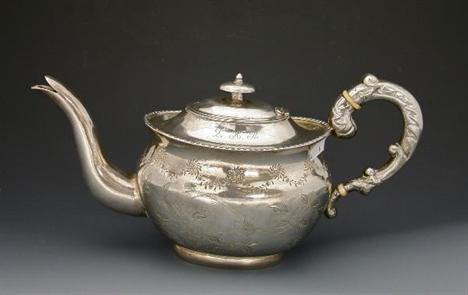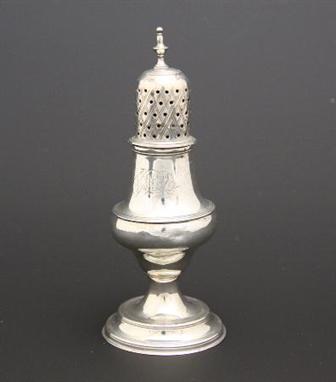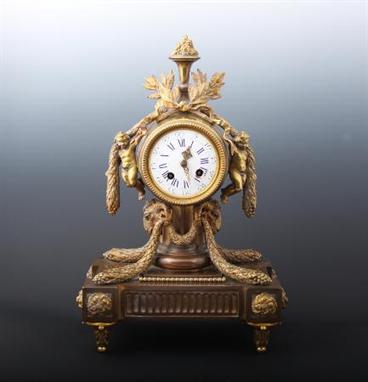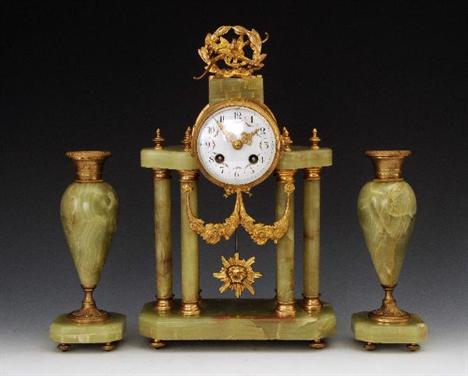We found 116099 price guide item(s) matching your search
There are 116099 lots that match your search criteria. Subscribe now to get instant access to the full price guide service.
Click here to subscribe- List
- Grid
-
116099 item(s)/page
A 19th century silver coloured metal mounted cameo emu egg, in the manner of H Steiner, carved with a bushman seated at his campfire, cast emu finial, spherical handles to sides, thepedestal as a tree with four leafy branches, oval ebonised base applied with cast models of an emu and a kangaroo, on a green velvet ground, ropetwist border, 25cm high, c.1880 Reference: Hawkins illustrates several similar objects Hawkins, John B, Nineteenth Century Australian Silver, vol. II, Antique Collectors` Club Ltd (Woodbridge 1990), pp. 120 - 130, pl. 374 - 379
A Chinese export bowed oval teapot, stiff leaf capped scroll handle, oval knop finial, gadrooned border, engraved with a band of stylised floral paterae draped with flowerhead and foliate swags above fanciful birds among branches, ivory insulators, 29cm long, character mark, late 19th/early 20th century
An Art Deco three piece tea service, comprising teapot, milk jug and two handled sugar basin, stylised flowerbud finial, flush hinged cover, engraved with stylised geometric bands, the teapot with bakelite angular handle, the milk and sugar with stylised fruiting branch handles, the former 27cm long, Charles S Green & Co Ltd, Birmingham 1934 & 1935, 32oz gross
An early 20th century American three piece canted spreading square coffee service, comprising coffee pot, cream jug and sugar basin, urnular finial with lotus boss, hinged cover, angular scroll handles, the coffee pot with ivory insulators, 20cm high, shape no. 8300, marked Sterling, Redlich & Company, New York, c.1920, 21oz gross
A 19th century French brass mantel timepiece, 9cm circular enamelled dial with Roman and Arabic numerals, twin winding holes, eight day movement striking on a bell, the drum case with fruit and ribbon tied laurel finial, flanked by putti and pendant swags, the whole raised on stop fluted column, flanked by ram`s masks, block rectangular stop fluted base, acanthus carved toupee feet, 42cm high, 28cm wide, c.1870
A 19th century French gilt metal cartouche shaped mantel clock, 9cm ivorine dial, with Arabic numerals, twin winding holes, eight day movement, signed A. Dehais, Paris, the bold case with urn finial, serpent handles and floral swags, masks to sides, on hairy paw feet, acanthus cast serpentine base, 59cm high, c.1870
A 19th century French gilt metal mounted green onyx Portico type clock garniture, the 9.5cm circular enamelled dial with Roman numerals, painted with floral swags, pierced gilt hands, twin winding holes, eight day movement, striking on a bell, the case with bird, quiver and wreath finial, raised on six tall columns, canted rectangular base, sun burst pendulum, ovoid side vases, the clock 38cm high, c.1890
A 19th century French porcelain mounted gilt metal mantel clock, ,the 8cm circular bleu celeste dial with Roman numerals, painted with floral garland, eight-day movement striking on a bell, the shaped rectangular case cast with a cherub flying on the back of a butterfly within four flaming urn finial, above female caryatid`s, the centre painted with cherubs frolicking with a goat, shaped base, 40cm high, c.1860
A fine 19th century French ormolu mantel clock, of monumental proportions, 11cm enameled dial with Roman and Arabic numerals, twin winding holes, eight day movement striking on a bell, urn finial, arched waisted rectangular case, supported by four winged caryatids, hoof feet, incurved rectangular base, toupee feet, 69cm high, 43cm wide, c.1850
A George III mahogany crossbanded oak longcase clock, 31cm arched painted dials inscribed Robt. Bradberry, Leyburn, Roman and Arabic subsidiary numerals, moon phase to arch, seconds subsidiary dial, date aperture, twin winding holes, eight day movement striking on a bell, the hood with swan neck pediment, brass ball and spire finial and brass capped Doric columns, arched rectangular door to waist, flanked by canted angles, bracket feet, 214cm high, c.1810 The Bradberrys were a peripatetic family of clockmakers, begun with Robert senior, of Wensley, N. Yorks., born 1749, married 1782, later of West Reeth, and Mathew (sic) probably a younger brother, born 1761, working at Wensley 1804/1811 and Richmond 1824. Robert`s son, Robert, who probably made this clock, was working at Wensley 1804/1811 and succeeded his uncle at Richmond by 1830. This is apparently the first recorded example of a clock by this family signed from Leyburn.
A George IV oak and mahogany crossbanded longcase clock, 33.5cm arched painted dial inscribed Sh**, Nottingham, Roman numerals, painted to the arch with a lady carrying an ale jug, to the spandrels with flowers, 30-hour movement striking on a bell, the hood with swan neck pediment, brass ball and spire finial and brass capped Doric columns, serpentine arched rectangular door to waist, shaped apron, bracket feet, 225cm high, c.1840 Anthony &George Shepperley entered into a partnership with William Pearce at Long Row Nottingham in 1828 and it was not dissolved until 1844. His son and grandson George and Philip continued the business into the 1860s.
A William IV oak and mahogany crossbanded longcase clock, 32cm arched painted dial inscribed Geo. Stacey, Worksop, Arabic numerals, painted to the arch and spandrels with colourful summer flowers, picked out in gilt, 30-hour movement striking on a bell, the hoof with swan neck pediment, brass ball and spire finial, turned columns, rectangular door to waist with incurved upper angles, rectangular base, 218cm high, c.1835 George Stacey is probably to be identified with the man of that name christened at North Wingfield (Derbys.) 31st March 1804, son of non-conformists William and Frances Stacey suggesting that he might well have been born around 1799. His apprenticeship indentures are missing, but he may have been trained by his near kinsman Thomas Stacey of Newark who died in 1820. He was certainly married by January 1822 when his son George was baptised at Tuxford, and he was working on his own account at Bridge Street Worksop by 1828 and a clockmaker and jeweller, being last recorded in 1855.
A `George III` oak longcase clock, 31cm square brass dial with silvered chapter ring inscribed Ratcliff, Holywell, Roman and Arabic subsidiary numerals, the spandrels pierced and cast with urns and leafy scrolls, subsidiary seconds, date and moon phase dials, blued steel hands, the associated case with architectural pediment inlaid in ebony with scrolling leafy stems, centred by a brass knop, ball and spire finial, above a dentil cornice and a pair of turned pilasters, shaped rectangular door to waist centred by an oval yew wood patera, mahogany crossbanded throughout and outlined with chequered banding and boxwood stringing, 232cm high,
A Victorian Neo-Gothic oak octagonal centre table, moulded top decorated in parquetry with radiating bands within geometric banded borders, the base with four turned columns carved with beaded girdles, X-stretcher with pyramid under-finial, downswept chamfered legs, 72cm high, 119cm wide, c.1870
A Victorian mahogany side cabinet, by Gillow & Co, Lancaster, stamped, rectangular panelled back with turned finial and open shelf, projecting base with moulded top above a pair of frieze drawers and open shelf and rectangular doors carved with bosses and leafy scrolls, turned feet, 165cm high, 153cm wide, c.1880
A Victorian rosewood and marquetry envelope card table, folding and turning top inlaid with leafy scrolls, enclosing a velvet lined playing surface and four dished counter wells, drawer to frieze, brass swing handle, shaped stretchers, turned and fluted under-finial, turned legs, ceramic casters, 75cm high, 54cm wide, c.1890
A collection of domestic brassware, late 18th and 19th century, comprising two cylindrical tobacco jars, the covers each with a finial, the largest 25cm high; two further examples of rectangular section; two door knockers, one with backplate cast as a lion’s face; and a finial cast as a hippocampus
A Regency Pontypool style Toleware Urn and Cover of oval form, the domed cover with decorative finial, openwork square section handles and on low pedestal with rectangular base, decorated with oval panels of ladies in 18th Century dress on a green striped ground, 23cms high max, 26.5cms wide maxe
Military interest- a Victorian presentation cup and cover R Garrard, London 1874, the deep bowl with twin scroll handles and presentation inscription and awards, the pull off domed cover with simple bud finial 22cm high, 35oz Notes: the presentation inscription reads `Challenge Cup presented to the Border Mounted Rifles by The Countess of Minto 1876` the opposing side with twelve annual awards
-
116099 item(s)/page
























































